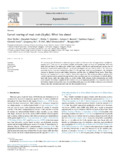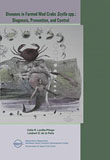Culture of Scylla serrata (Forskal) in cement ponds
- Global styles
- MLA
- Vancouver
- Elsevier - Harvard
- APA
- Help

View/
Date
2015Page views
4,504ASFA keyword
AGROVOC keyword
Taxonomic term
Metadata
Show full item record
Share
Abstract
Male and female Scylla serrata juvenile crabs were stocked separately in cement ponds (14 x 8 x 0.8 m; 90 m3) and reared for 90 days. The study was conducted at the Fisheries Research Station, JAU. Okha, Gujarat. The crabs were fed trash fish and Trochus spp.The survival rates of male and female crabs were higher in Run 1 at 66.11% and 45.55%, respectively, than in Run 2 at 13.9% and 6.1%, respectively. The mean body weights of males (1,704 g) and females (994.5g) in Run 1 were higher compared to those in Run 2 (381.2 g for males and 104.5 g for females). However, there were no significant differences (P>0.05) in the average daily weight gain of 0.19 g day-1 for males and 0.13 g day-1 for females in Run 1 and 0.16 g day-1 for males and 0.13 g day-1 for females in Run 2. The water parameter levels were within the optimum ranges for mud crab culture.The results indicate that it is not commercially viable to grow juveniles to market size in cement ponds based on the conditions in this study.
Suggested Citation
Kotiya, A. S., Solanki, J. B., & Akolkar, N. G. (2015). Culture of Scylla serrata (Forskal) in cement ponds. In E. T. Quinitio, F. D. Parado-Estepa, Y. C. Thampi Sam Raj, & A. Mandal (Eds.), Proceedings of the International Seminar-Workshop on Mud Crab Aquaculture and Fisheries Management, 10-12 April 2013, Tamil Nadu, India (pp. 93-99). Tamil Nadu, India: Rajiv Gandhi Centre for Aquaculture (MPEDA).
Type
Conference paperISBN
9788192989815
Related items
Showing items related by title, author, creator and subject.
-
Larval rearing of mud crab (Scylla): What lies ahead
Waiho, Khor; Fazhan, Hanafiah; Quinitio, Emilia T. ; Baylon, Juliana C.; Fujaya, Yushinta; Azmie, Ghazali; Wu, Qingyang; Shi, Xi; Ikhwanuddin, Mhd; Ma, Hongyu (Elsevier, 2018)
The increasing global demand for mud crabs (genus Scylla) and threats to the wild populations highlight the urgency of fully rearing them in captivity. Despite considerable progress in mud crab production, most crab farms ...
; Baylon, Juliana C.; Fujaya, Yushinta; Azmie, Ghazali; Wu, Qingyang; Shi, Xi; Ikhwanuddin, Mhd; Ma, Hongyu (Elsevier, 2018)
The increasing global demand for mud crabs (genus Scylla) and threats to the wild populations highlight the urgency of fully rearing them in captivity. Despite considerable progress in mud crab production, most crab farms ... -
Diseases in farmed mud crabs Scylla spp.: Diagnosis, prevention, and control.
Lavilla-Pitogo, Celia R.; de la Peña, Leobert D. (Aquaculture Dept., Southeast Asian Fisheries Development Center, 2004-12)Aquaculture production has suffered many set-backs due to the occurrence of diseases. Many of the diseases are caused by infectious organisms that are difficult to detect and need sophisticated instruments for diagnosis, ... -
Mud crab pond and pen culture
Rodriguez, Eduard M. (University of the Philippines Aquaculture Society, Inc, 2001)




